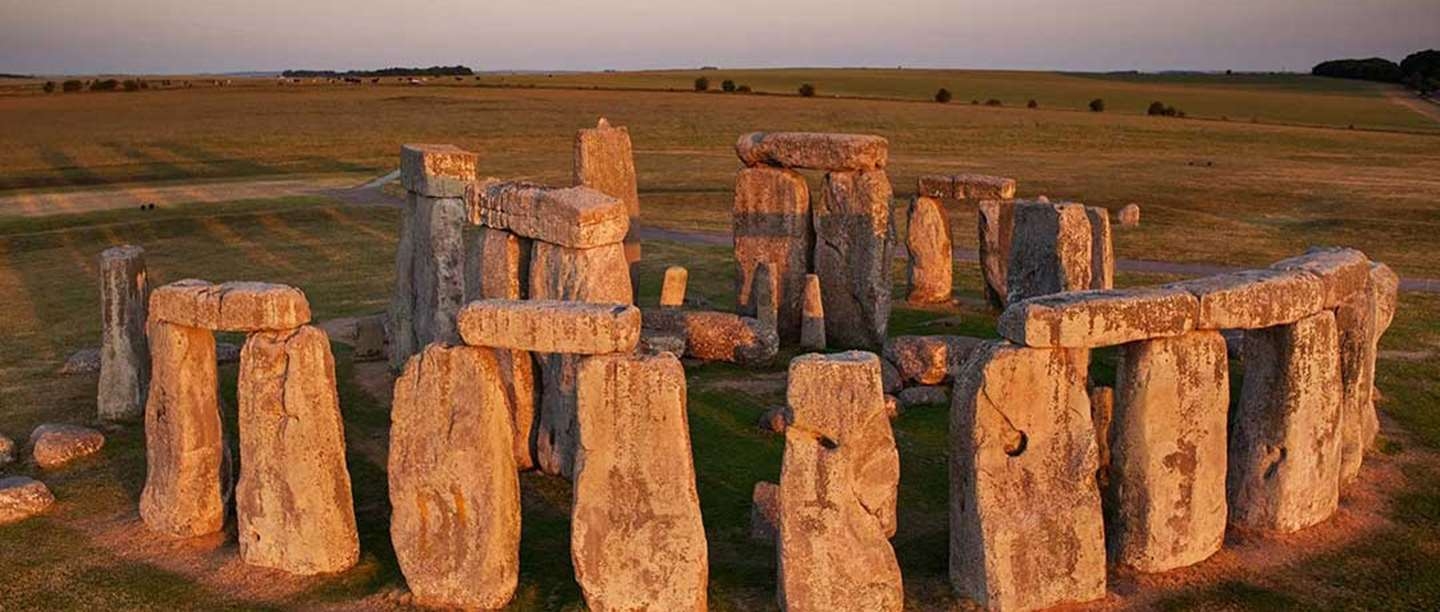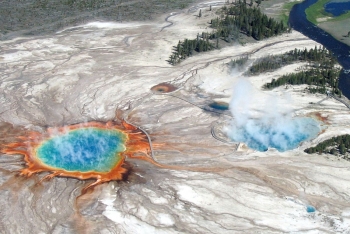Mystery Behind How Stonehenge Was Built
 |
| Stonehenge. Photo: english-heritage |
Located in southern England, Stonehenge is comprised of roughly 100 massive upright stones placed in a circular layout. Nearly 1 million people annually visit Stonehenge, a UNESCO World Heritage Site since 1986.
History of Stonehenge
Stonehenge is perhaps the world’s most famous prehistoric monument. It was built in several stages: the first monument was an early henge monument, built about 5,000 years ago, and the unique stone circle was erected in the late Neolithic period about 2500 BC. In the early Bronze Age, many burial mounds were built nearby.
Today, together with Avebury, Stonehenge forms the heart of a World Heritage Site, with a unique concentration of prehistoric monuments, according to English Heritage.
Who Built Stonehenge?
According to the 12th-century writer Geoffrey of Monmouth, whose tale of King Arthur and mythical account of English history were considered factual well into the Middle Ages, Stonehenge is the handiwork of the wizard Merlin. In the mid-fifth century, the story goes, hundreds of British nobles were slaughtered by the Saxons and buried on Salisbury Plain.
Hoping to erect a memorial to his fallen subjects, King Aureoles Ambrosias sent an army to Ireland to retrieve a stone circle known as the Giants’ Ring, which ancient giants had built from magical African bluestones. The soldiers successfully defeated the Irish but failed to move the stones, so Merlin used his sorcery to spirit them across the sea and arrange them above the mass grave. Legend has it that Ambrosias and his brother Uther, King Arthur’s father, are buried there as well.
While many believed Monmouth’s account to be the true story of Stonehenge’s creation for centuries, the monument’s construction predates Merlin—or, at least, the real-life figures who are said to have inspired him—by several thousand years. Other early hypotheses attributed its building to the Saxons, Danes, Romans, Greeks or Egyptians.
In the 17th century, archaeologist John Aubrey made the claim that Stonehenge was the work of the Celtic high priests known as the Druids, a theory widely popularized by the antiquarian William Stukeley, who had unearthed primitive graves at the site. Even today, people who identify as modern Druids continue to gather at Stonehenge for the summer solstice. However, in the mid-20th century, radiocarbon dating demonstrated that Stonehenge stood more than 1,000 years before the Celts inhabited the region, eliminating the ancient Druids from the running.
Many modern historians and archaeologists now agree that several distinct tribes of people contributed to Stonehenge, each undertaking a different phase of its construction. Bones, tools and other artifacts found on the site seem to support this hypothesis. The first stage was achieved by Neolithic agrarians who were likely indigenous to the British Isles. Later, it is believed, groups with advanced tools and a more communal way of life left their stamp on the site. Some have suggested that they were immigrants from the European continent, but many scientists think they were native Britons descended from the original builders.
What was Stonehenge used for?
 |
| Photo: history |
Stonehenge was built as a burial site
One theory suggests that Stonehenge was used as a Late Neolithic burial site and a monument to the dead – or at least it was for 500 years during the first two phases of its construction from ~3,000 BC until the monuments were erected in ~2,500 BC.
Charred remains were unearthed in holes around the site, known as the Aubrey Holes, that once held small standing stones. Analysis of the bones suggests they were buried during this 500-year period. After 2,500 BC, the people who used Stonehenge stopped burying human remains in the stone circle itself and began burying them in ditches around the periphery, suggesting a shift in the cultural significance of Stonehenge.
The evidence to support this theory is dotted all around the landscape around the monument; the area within a 2-mile radius of Stonehenge contains hundreds of Bronze Age burial mounds, or ‘tumuli’.
These burial mounds are unique for their dense, grouped distribution across the landscape, and are frequently within sight of the stone circle itself. The spiritual significance of this shouldn’t be understated; being buried in direct sight of Stonehenge undoubtedly held a great deal of significance for Neolithic Britons.
Stonehenge is a giant astronomical calendar
Another theory makes reference to Stonehenge’s celestial influence and apparent alignment with the sun, moon, and stars – akin to an ancient scientific observatory that connected the Earth to the sky. Researchers have studied the standing bluestones at Stonehenge, and believe they were carefully placed in their surroundings based on early astronomical knowledge.
The team of researchers studied Stonehenge, as well as several other stone formations across the UK, and came to the conclusion that Stonehenge was likely built to track the movement of the sun, moon, and stars thousands of years ago. An analysis of the position and orientation of the stones, compared with well-known astronomical alignments, has revealed a strong alignment with the movements of the sun and moon in particular, Evanevanstours reported.
Building Stonehenge
Stonehenge’s Multiphase Construction
Archaeologists believe England's most iconic prehistoric ruin was built in several stages, with the earliest constructed 5,000 or more years ago. First, Neolithic Britons used primitive tools—possibly made from deer antlers—to dig a massive circular ditch and bank, or henge, on Salisbury Plain. Deep pits dating back to that era and located within the circle—known as Aubrey holes after John Aubrey, the 17th-century antiquarian who discovered them—may have once held a ring of timber posts, according to some scholars.
Several hundred years later, it is thought, Stonehenge’s builders hoisted an estimated 80 non-indigenous bluestones, 43 of which remain today, into standing positions and placed them in either a horseshoe or circular formation.
During the third phase of construction, which took place around 2000 B.C., sarsen sandstone slabs were arranged into an outer crescent or ring; some were assembled into the iconic three-pieced structures called trilithons that stand tall in the center of Stonehenge. Some 50 sarsen stones are now visible on the site, which may once have contained many more. Radiocarbon dating suggests that work continued at Stonehenge until roughly 1600 B.C., with the bluestones in particularly being repositioned multiple times, History wrote.
The mysteries of building Stonehenge
One of the major mysteries of Stonehenge was how it was built.
The ditch and bank itself would have been dug with antler picks about 6 feet deep and piled up to make a bank about 6 feet high. At the time of creating the bright white fresh chalk would have contrasted vividly against the surrounding grassland.
Archaeologists may now know how Stonehenge was built
CNN reported that in 2019, researchers revealed that the huge bluestones had been moved to their present location, from their place of origin - “an ancient quarry on the north side of the Preseli Hills in western Wales” - “a staggering distance of 150 miles.”
Now, archaeologists think that prior to their arrival at their current location, some of the bluestones had “formed another stone circle close to the same area as the quarries,” were dismantled, and then “rebuilt as part of Stonehenge on the Salisbury Plain,” the report said.
CNN cites new research published in the journal Antiquity, which states that “the identical 110-meter diameters of the stone circle, known as Waun Mawn, and the enclosing ditch of Stonehenge, suggest that at least part of the circle was brought from its location in Wales to Salisbury Plain.”
And there’s more evidence. The paper added that “both stone circles are aligned on the midsummer solstice sunrise, and one of the bluestones at Stonehenge has an unusual cross-section that matches one of the holes left at Waun Mawn,” adding that “chippings in that hole are of the same rock type as the Stonehenge stone.”
The first stones - the bluestones from the Preseli Hills
The first stones, the bluestones (weighing around 4 tons each) were sourced from the only place in the UK where such stone exists, in the Preseli Hills in north Pembrokeshire in Wales, nearly 200 miles away. There is much archaeological debate surrounding the theories of how the stones got from Wales to Salisbury Plain.
A popular theory with some academics is that these stones were quarried from the spot in Wales and then transported largely by water, and then by log roller systems overland to the site of Stonehenge. However, nobody has even today successfully re-enacted this feat with the technologies available at the time. Nor found any evidence along the way to support this. The other major and perhaps more plausible theory suggests the stones were moved naturally to Stonehenge by glaciers during the Ice Age.
The big ones - the Sarsen stones
The larger stones the Sarsen stones came from only about 20 miles away, but again with no modern machinery and before the wheel, this would have been a huge undertaking, through the undulating countryside. The sarsens would have been roughly cut where they were found, and then dragged on top of tree trunks, working as rollers, to Stonehenge. It has been estimated that as many as one thousand people would have been needed for the man-power to haul these gigantic stones and perhaps taking ten years to complete.
An elite group of knowledge
Due to the complexity of organizing such a mammoth task, it seems likely that an elite group of people possessed and passed on specialist building knowledge, as a guild today, organizing the engineering within local - and more distant - communities. Leaders over many generations must have been able to inspire the masses into the concepts and beliefs that drove them to attempt such a monument.
Stonehenge itself is put together like woodwork. Joints and sockets have been carved into the stone so each stone fits into each other precisely. Stonehenge is unique in that it has horizontal stones to form arches. These horizontal stones have been engineered so they were flat, on a sloping site. Stonehenge is also unique in that the stones have been shaped into flat-sided blocks.
An army of people
Without metal, it would have been very labor-intensive to shape these vast stones using stone on stone. A whole army of people would have been required on-site to perform the shaping. We know this as the land around Stonehenge is full of the chippings.
How did they get those huge stones up there?Erecting the stones also would have been problematic without modern aids. Ditches would have been dug into which the stones would be sited. The uprights we see at Stonehenge have about a third of their length concealed below ground. The most common theory is that large earthen ramps would have been erected and the stones toppled over the top into their prepared holes and somehow pulled vertical, perhaps with primitive A-frames for leverage, according to Londontoolkit. |
Stonehenge In The 21st Century
 |
| Photo: nydailynews |
Stonehenge is the world’s most famous stone circle, visited by more than a million people per year. It stands as an icon for all that is mysterious and awe-inspiring about humanity’s prehistoric past. For well over a century, people have gathered at the monument to celebrate the summer solstice. Although banned in 1985 as a result of violent clashes with police, the annual gathering resumed in 2000 and now draws a crowd of more than 30,000. Modern-day Druidic societies have claimed Stonehenge as their own temple, even though the identification of Stonehenge with the original Druids is suspect. The first such society, the Ancient Order of Druids, was formed in 1781; more recently, the number of similar Druidic and other Neo-Pagan groups has risen in tandem with the decline in conventional religious belief, Britannica wrote.
 Mysterious Dogecoin address sending binary code to Elon Musk: Who behind? What the code means? Mysterious Dogecoin address sending binary code to Elon Musk: Who behind? What the code means? A mysterious address believed to own $3 billion worth of Dogecoin crypto sent a binary code to Elon Musk. Many speculations have been raised around ... | ||||
|






























